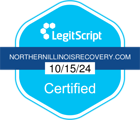Naltrexone, a medication known for treating opioid and alcohol use disorders, has shown promise as a weight loss aid. Its mechanism for promoting weight loss involves several factors related to how it interacts with the body’s biochemical pathways.
What Is Naltrexone?
 Naltrexone is a medication approved by the Food and Drug Administration (FDA) to treat both alcohol use disorder (AUD) and opioid use disorder (OUD). It is viewed as a medication-assisted treatment option. Naltrexone can be prescribed and administered by a practitioner who is licensed to prescribe medications.
Naltrexone is a medication approved by the Food and Drug Administration (FDA) to treat both alcohol use disorder (AUD) and opioid use disorder (OUD). It is viewed as a medication-assisted treatment option. Naltrexone can be prescribed and administered by a practitioner who is licensed to prescribe medications.
It is available as an extended-release intramuscular injectable for alcohol and opioid use disorder. And it is available in a pill form for alcohol use disorder.
Naltrexone is taken daily and the extended-release injectable can be administered by a practitioner every four weeks, or once a month. It is usually ReVia or Depade and it can be taken at 50 mg once per day. The injectable extended form of naltrexone is Vivitrol and it’s administered at 380 mg intramuscular once a month.
Naltrexone plays a significant role in our Illinois addiction treatment center as it is not addictive, is not an opioid, and doesn’t cause withdrawal symptoms without stopping use. It blocks the sedative and euphoric effects of opioids such as morphine, codeine, and heroin. Naltrexone blocks and binds opioid receptors, yet it also suppresses and reduces opioid symptoms and cravings. There is no diversion potential or abuse with naltrexone.
Naltrexone for Weight Loss

Low-dose naltrexone aids in weight loss, especially for those with insulin resistance or overeating issues. Combined with a reduced-calorie diet and an exercise program, it often yields significant results. It’s typically prescribed with bupropion as Contrave®. Taking naltrexone in the early morning can reduce appetite by 30%, aiding weight loss. Morning dosing suppresses cravings all day, enhancing your weight loss regimen.
It is an opioid receptor antagonist, and naltrexone/bupropion is a norepinephrine reuptake inhibitor. The uses for Naltrexone vary from weight loss to chronic pain management. Naltrexone for weight loss has yielded positive results. This medication assists individuals in losing weight by reducing the desire for food. When combined with bupropion, it can effectively treat obesity in patients.
Bupropion is an antidepressant that can help people lose weight through the suppression of appetite. A low dose of naltrexone blocks an individual’s hunger signals to the brain, and the body won’t feel the need for food. Eventually, the suppressed hunger will become a habit, and the individual will feel forced to make dietary changes.
How Naltrexone for Weight Loss Works
Firstly, naltrexone works by binding to opioid receptors in the brain. This binding action can decrease the release of dopamine, a neurotransmitter that plays a significant role in the body’s reward system. By reducing the dopamine release associated with eating, naltrexone may help diminish the rewarding aspects of food, potentially leading to reduced food consumption.
This effect was observed in studies where naltrexone showed a capacity to decrease food intake in rodents, suggesting a similar appetite-suppressing effect could contribute to weight loss in overweight and obese adults.
Various patients have reported that the drug increases their energy during the day. Therefore, enhanced physical activity is a potential outcome of such an impact. As a result, several individuals might burn extra calories and lose a couple of pounds.
It’s proven that this drug assists in lowering insulin levels by 40% and the link between obesity and insulin levels are straightforward. One of the primary causes of increased mass in individuals is insulin resistance, specifically in hypothyroid patients. The low dose of Naltrexone for weight loss works by regulating cellular resistance to insulin.
A lack of sufficient sleep can cause inflammation and lead to an increase in body fat in individuals, according to several studies. Low-dose naltrexone has been proven to improve sleep quality in individuals with sleep apnea and pain syndromes. This is one of the ways that the drug assists in weight loss.
Research suggested that the medication can increase growth hormones in specific patients. Therefore, a low dose of Naltrexone for weight loss works in these patients due to the stimulating growth hormones. They assist not only by building but also by maintaining lean muscle mass yet increasing the burning of fat.
Vivitrol for weight loss can assist in increasing a person’s total triiodothyronine (TT3) levels and improve the conversion of total thyroxine (TT4) to total triiodothyronine (TT3). Furthermore, low-dose Naltrexone improves the immune system and reduces autoantibodies in autoimmune conditions.
These are two reasons why low-dose naltrexone is used for Hashimoto’s thyroiditis. The medication helps because of thyroidal gland destruction when combined with autoantibodies and results in an increased mass in individuals.
Obesity-Related Risk Factors
Being overweight or obese is associated with a range of health risks that can affect almost every part of the body. These risks include chronic conditions, acute diseases, and can also impact mental health and quality of life. Unfortunately, the risk factors associated with being overweight or obese is extensive. Weight management and body mass index prove to be one of the most important aspects of being a healthy person. Some obesity-related risk factors include:
- Cardiovascular disease
- Blood pressure issues
- Type 2 diabetes/ Blood sugar issues
- Certain cancers
- Sleep apnea
- Osteoarthritis
- Kidney disease
- Mental health issues
How Does Low Dose Naltrexone Work?

The FDA-approved weight-loss medication naltrexone HLC treats overweight and obese patients. Low-dose naltrexone can work to suppress a patient’s appetite. The combination of weight loss medications will suppress sugar and carb cravings to stop eating once and for all, plus improve mood.
- Improve mood: The combination of LDN weight loss medications triggers an increase in dopamine and serotonin production, which can decrease stress and anxiety. Therefore, reducing emotional eating.
- Improve sleep: Lack of sleep has negative effects on an individual’s body’s hormonal system and can lead to weight gain. Naltrexone battles this harmful cycle.
- Regulate appetite: Naltrexone can assist in normalizing a person’s metabolism, and matching appetite to resting energy spending.
- Reduce insulin resistance: Naltrexone regulates cellular resistance to insulin, which can lead to weight loss.
Naltrexone for Opioid Use Disorder
To reduce the risk of withdrawal symptoms that are caused by OUD, patients should wait for at least 7 days after their last use of short-acting opioids. Furthermore, they should wait 10 to 14 days for long-acting opioids, before beginning naltrexone. When patients are engaging in naltrexone, they should not engage in any of the following:
- Opioids or illicit drugs
- Take sedatives
- Drink alcohol
- Tranquilizers
- Other drugs
Patients should notify their practitioner about all the medications they are taking and medication changes while being treated for naltrexone. Even though the oral formulation blocks the opioid receptors, the long-acting injectable formulation in MAT is FDA-approved and requires REMS.
The patients on naltrexone who relapse after an abstinence period or who discontinue use might have a reduced opioid tolerance. Therefore, engaging in lower dosages or taking the same amount of opioids used in the past can cause dangerous consequences.
Naltrexone for Alcohol Use Disorder
Upon starting naltrexone for AUD, patients shouldn’t be physically dependent on alcohol or other substances. To avoid strong side effects such as nausea and vomiting, practitioners generally wait until after the detox process has passed before administering naltrexone.
Naltrexone binds to the endorphin receptors in an individual’s body and blocks the feelings and effects of alcohol. It reduces alcohol cravings and the amount of alcohol consumed. Once a patient stops engaging in alcohol use, taking naltrexone assists in maintaining during recovery.
The naltrexone/bupropion MAT Treatment will last for three to four months. The practitioners should continue monitoring the patients who are no longer taking naltrexone.
What Was Naltrexone Originally Intended to Treat?
Naltrexone was originally intended to treat narcotic drug addicts to stay off of narcotics. It was approved in 1984 by the FDA. It was first used for preventing various substance abuse with addiction potential. Alcohol, tobacco, and painkiller addictions have been treated with this drug.
The mechanism in which a person can manage these addictions might be the same in which it helps manage eating habits. Since naltrexone is an opioid antagonist, it might work by affecting the reward system and various other systems to influence body weight and food intake.
In a study on bupropion and naltrexone combination, medication can help reduce brain activity in several areas associated with food cravings. The areas of the brain that showcased decreased activity are associated with interoception (sensation of being hungry), saliency attribution (relative importance of food), and craving.
In a double-blind placebo-controlled study, 20 participants and the volunteers were given pasta and then asked to stop eating on an occasional basis to provide feedback about their appetite. Naltrexone reduced the pleasantness of the food and the eating rate. Once the participants took naltrexone, they significantly ate less than when they received a placebo and without a pill.
Naltrexone is typically taken at night and might provide additional benefits that can assist with weight loss. It has been shown that for patients with chronic pain, Naltrexone can improve sleep. A study with 68,183 women over 16 years of age found that engaging in less than five hours of sleep every night produces a greater risk of weight gain.



